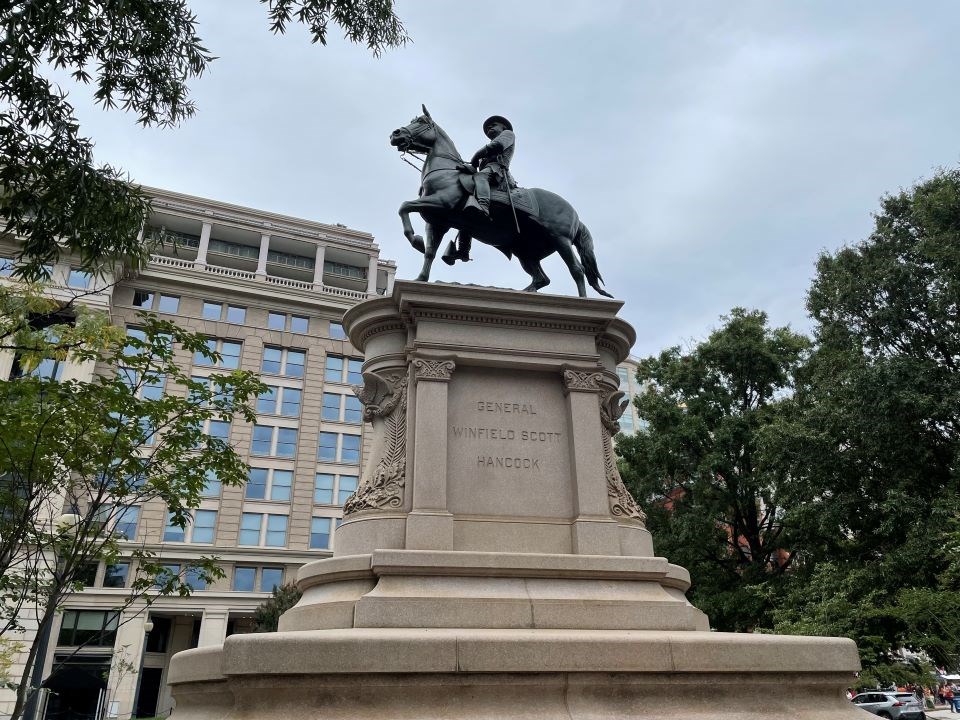
Not far from the Navy Memorial on Pennsylvania Avenue resides the equestrian statue to Civil War general Winfield Scott Hancock. Born in 1824, his parents named him after the War of 1812 hero, Winfield Scott. Hancock attended West Point and was stationed in the Red River Valley following graduation. He first saw combat during the Mexican-American War, serving under the invading U.S. army led by his namesake. After the conclusion of the war, the military stationed him in St. Louis where he met and married Almira Russell. Assigned to Los Angeles when the Civil War began, Hancock returned East as a quartermaster, but was quickly promoted to brigadier general and given an infantry command. His heroic efforts at the Battle of Williamsburg led to his nickname of “Hancock the Superb,” and following the Battle of Antietam he was promoted to major general. An even more pivotal moment in his military career occurred in the following year. On July 1, 1863, the first day of the Battle of Gettysburg, the Union army lost one of their best corps commanders, General John F. Reynolds. Reynolds had been commanding the left wing of the Army of the Potomac, and upon his death General Meade replaced him with Reynolds's friend Hancock. Arriving around dusk on July 1, Hancock rallied the troops from the brink of chaos. During the third day of the battle, he commanded his men as they repulsed Pickett’s Charge at Cemetery Ridge. As the Confederates retreated, Hancock was grievously wounded but refused to leave the battlefield. After a period of recuperation and light duty, he returned to the war in 1864, leading troops at Cold Harbor, the Wilderness, and the Siege of Petersburg. Following the war, Hancock was charged with carrying out the execution of four of the convicted conspirators in the assassination of President Lincoln. In 1866, while in command of the military district of Texas and Louisiana, he issued orders that effectively returned pre-war rights to white citizens at the expense of African Americans. Those actions were condemned by Radical Republicans in Congress but increased Hancock’s visibility and popularity within the Democratic party. He continued to serve under Presidents Grant and Hayes, mostly on the western plains and the Dakota Territory, before deciding to seek the presidency himself. In 1880, Hancock won the nomination for the Democratic party, but Republican James Garfield very narrowly defeated him in the presidential election. Following this defeat, he continued his military career as commander of the northeastern United States, headquartered at Governor’s Island in New York City. On August 8, 1885, he presided over the nine-mile-long funeral procession for General Ulysses S. Grant in New York City. This was his last official public act in the military as he died six months later on February 9, 1886. Three years after his death, Congress approved funds for an equestrian statue of Winfield Scott Hancock. Congress selected Henry Jackson Ellicott to complete the statue. Ellicott was the great-grandson of Andrew Ellicott who had helped design Washington, DC. The statue was commissioned in 1889 and finished seven years later at a cost of $50,000. On May 12, 1896, President Grover Cleveland and other dignitaries dedicated the statue. President Cleveland called special attention to the Civil War veterans present honoring their sacrifice. Senator John Palmer from Illinois, who had served with Hancock, spoke and honored his memory by quoting General Grant’s opinion of him: “His genial disposition made him friends and his personal courage and his presence with his command in the thickest of the fight won for him the confidence of the troops serving under him.” |
Last updated: October 12, 2021
